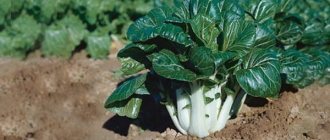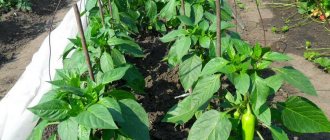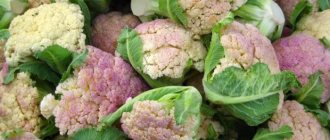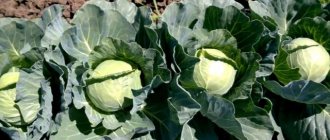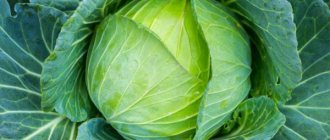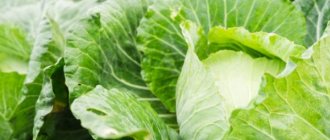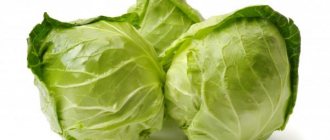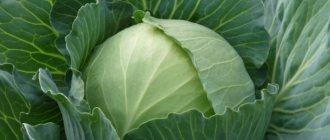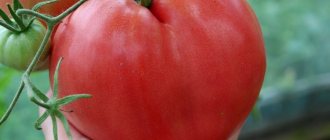Kale, or kale, is an unusual variety of cabbage that has escaped genetic modification and domestication. During World War II in France, Jerusalem artichoke saved people from hunger and vitamin deficiency. At the same time, in England it was cabbage of this variety that helped prevent people from starving to death. Kale, like Jerusalem artichoke, acquired the title of “forgotten vegetable” for many years. Nowadays, it is returning to tables thanks to popular restaurants that actively use the leaves to prepare their dishes.
Name and homeland of Kale
Curly cabbage has more than one name. It is also called kale (the emphasis is on the second syllable), brunkol, braunkol, grunkol. But no matter what the vegetable is called, it looks the same in any case: its fringed leaves can have a purple or green tint, and they do not form a head. That is why in Latin the name of the product is Acephala or Brassica oleracea, which means “unattached, unattached.” This variety has a high stalk, sometimes reaching one meter, from which the leaves spread loosely in all directions. Scientists are confident that grunkol is the most ancient type of wild cabbage.
Brauncoli manages to grow even under the most extreme climatic conditions. After suffering frosts, it turns out even juicier and sweeter. In Europe, curly cabbage was the most popular green vegetable until the end of the Middle Ages. Many countries cultivated the leaf, but over time other crops replaced the vegetable. When this variety was remembered again, it was already considered exotic, especially in our latitudes.
But, nevertheless, not a single state considers itself the birthplace of grunkol. Cabbage is loved in all countries, but everywhere it is considered brought from another country. The Germans call kale a French crop, in England it is widely believed that this cabbage comes from Scotland or Siberia, and for the Dutch it is a German “subject”. In the UK and USA, kale appears under the name Red Russian kale - Red Russian cabbage. They say that merchants from Russia brought the leaves to America on ships, after which the product firmly established itself in California gardens. Trade relations between Arkhangelsk and London contributed to the second coming of kale to England.
Caring for seedlings and bushes
When the plants reach 7-8 cm they can be thinned out; the preferred distance between thinned bushes is 30-60 cm (the distance depends on the variety).
Water either in the morning or in the evening. It is not recommended to water in the middle of the day. Young sprouts need moisture, but as they mature, the number of waterings should be reduced. We must remember that overdrying the soil is one of the reasons for the appearance of nitrates in the fruiting body of a vegetable.
Increased levels of nitrates can be caused by the use of fresh manure. Manure that has been rotted should be used. Excess nitrates can be caused by increased doses of mineral nitrogen and a lack of potassium.
Morning watering of planted cabbage
On infertile land, after 10 days have passed since the seedlings were planted, it is necessary to add 10 g of urea, 15-20 g of superphosphate and potassium salt (the listed fertilizers must be dissolved in 10 liters of water). The second feeding should be done after 20 days. The second feeding should be increased by 1.5 times, and the following should be added to it: ammonium molybdate (1 g in quantity) and borax (3 g in quantity).
Types of brauncolleaf cabbage
Kale has many varieties:
- Siberian cabbage is a variety resistant to low temperatures and various pests.
- Reed - its height can reach almost two meters. The peculiarity of this species is that it has a heavy stem that can be used as a cane.
- Red Russian - has the same properties as Siberian, but is externally distinguished by the presence of twisting, expressive red leaves.
- Curly cabbage is the most common variety of kale (cabbage). It is distinguished from other varieties by its softer and sweeter taste. The leaves of the crop have a wrinkled and curly appearance.
- Redbor F1 cabbage can be dark purple or red in color, so this variety is often used to give dishes certain tones.
- Tuscan cabbage is distinguished by elongated thin leaves that have a wrinkled structure.
- Premier cabbage is a frost-resistant, fast-growing variety.
Whatever the variety of kale (kale), it is best to eat its leaves raw, adding them to salads with young garlic, tomatoes and basil. In this way, the beneficial properties of the crop will be preserved much better.
Harvest and storage
Cleaning is carried out in one of two ways:
- they tear off the larger side leaves and leave the smaller leaves;
- The entire plant is cut off and stored in a cool place until processing.
When to collect
Growing leaves are collected throughout the summer . The younger they are, the more tender and tasty they are. They are cut early in the morning, when the leaves are maximally saturated with moisture.
As soon as during the growth process the leaves begin to coarse and lose their taste , the final harvest is carried out. The entire growing season lasts up to 180 days.
Storage features and keeping quality of the Redbor F1 hybrid
At room temperature, cabbage is stored for no more than 2-3 days, then it withers . Refrigerate for a maximum of 7 days. The leaves are placed in a container with water, like a bouquet, and covered with a plastic bag on top.
Freezing helps preserve this product for a long time . The leaves are pre-washed and dried at room temperature, spread on paper or cloth napkins. It is advisable to cut off the stems and veins, leaving only the leaf blade.
Composition of bruncole cabbage
Kale contains many minerals, folic acid, approximately 20% magnesium, calcium, copper and potassium. Curly cabbage, a photo of which can be seen in our article, is enriched with vitamins A and C. Approximately 50% of them are found here. The culture contains vitamins B1, B2, B6, and E in slightly smaller quantities.
The product also contains vitamin K, which is extremely important for the human body. Provitamin A (beta-carotene) is also included in kale. The product contains 85% of the daily dose of the substance. One hundred grams of brown cabbage contains 28 kcal.
Kale - what kind of cabbage is this?
What is kale? Cabbage, which is considered a super food, that is, a product whose benefits for humans is off the charts. This group also includes chia seeds, goji berries, etc. In terms of iron percentage, kale exceeds beef and is quite rich in protein. Kale leaves contain more calcium than milk, and the same amount of magnesium (47 mg). Twice as much vitamin C as an orange.
Moreover, this type of cabbage is characterized by the fact that it does not have a head, only a stem. The leaves can be curly, smooth or arrow-shaped, which determines its variety. Most often you can find Tuscan or, as it is also called, dinosaur cabbage, with its distinctive curly leaves.
Useful properties of bruncole cabbage
Curly cabbage has a number of positive properties, for which it is necessary to grow this vegetable. The product helps eliminate calcium deficiency. One gram of cabbage contains about 1.35 milligrams of this substance, while the same amount of milk contains only 1.13 milligrams. Calcium from this cabbage is absorbed by the body 25% better than calcium from milk. For people who suffer from milk protein intolerance, kale is an invaluable source of calcium.
Due to the increased content of vitamin C, bruncol is considered an excellent antioxidant of natural origin. The low calorie content of browncoli helps fight excess weight. Despite the minimal calorie content, the vegetable fully saturates the body with most of the essential substances. Therefore, vegetarians give culture a place of honor in their diet menu.
Kale is considered an unsurpassed substance for the prevention of vision. The culture is called the queen of carotenoids, since one cup of the product contains 200% of the daily value of vitamin A.
How to eat kale
The leaves are eaten both fresh and after preliminary heat treatment. Young leaves have excellent taste, have a delicate texture, and are devoid of bitterness and astringency.
The stem and head are too hard, so they are used as fodder. In cooking, the juice is squeezed out of the stem, which is then used as a dressing and added to vegetable cocktails.
Cooking Kale
Bruncol serves as a wonderful ingredient for many dishes. Kale (recipes below) can be a component of salad or soup. You can make a delicious salad from the young leaves of the vegetable. To create it you will need eight small leaves of cabbage, one hundred grams of feta cheese, one glass of red currants (gooseberries, raspberries, black currants, grapes or apple slices), a little cold-pressed olive oil, a quarter glass of quinoa, parsley, dill, green onions to taste .
Washed and dried kale leaves should be cut into thin strips. Then finely chop the onion and herbs, beat some of the berries in a blender. Mix berry puree with salt, olive oil and pepper. Now combine the cereal, herbs, onions and cabbage in a bowl and mix the salad with berry dressing. It is recommended to decorate the top of the dish with pieces of cheese and remaining berries.
To prepare soup with cabbage grunkol you should prepare:
- One hundred ml of cream.
- One glass of chicken or vegetable broth.
- 400 g frozen peas.
- White pepper, salt.
- One potato.
- 200 g kale.
- Two tablespoons of grated Parmesan cheese.
- One or two sprigs of mint.
- Three or four sprigs of basil.
Peel the potatoes and cut into large pieces. Boil potatoes and peas in two containers. Combine the boiled products with chopped cabbage leaves and broth and beat everything with a blender. Add chopped basil and mint leaves, Parmesan, cream to the puree and place the container with the soup on low heat. Stirring all the time, heat the dish for two minutes. The dish is served with crackers.
Growing Kale from Seeds
Cabbage is not very demanding when it comes to soil composition, so it will not require any special care. It grows and develops in any soil, the main thing is that it is fertile enough to grow foliage. Growing seedlings occurs according to the following plan:
- sowing seeds for seedlings 45-60 days before the expected date of planting in open ground;
- preparing a light and loose soil mixture of peat, sand and garden soil in a ratio of 10:1:4;
- soaking the seeds (15 minutes at a temperature of +50 degrees, then 5 minutes in cold water);
- germination of seeds in damp gauze (cotton pads, fabric, etc.), in a warm place for 3 days;
- sowing in seedling boxes to a depth of 1-1.5 cm.
Cabbage does not like thickening, so it is better to use a spacious container and sow the seeds at a distance of 4-5 cm so that they do not interfere with each other. At a temperature of +20-22 degrees, the first seedlings will appear within a week. Before the seedlings emerge, it is better to cover the seedling box with film.
Planting a crop
As a rule, the crop is grown from seeds that are planted in open soil. Curly cabbage, the seeds of which need to be planted in mid-April or early May, does not tolerate transplantation well. Therefore, it is better not to touch the sprouts that have already emerged from the soil. The soil temperature for seeds should be 50 degrees. In each hole you need to add a little humus with wood ash.
Curly cabbage (kale) grows very quickly. Seeds germinate on the fifth to seventh day after planting. At home, the crop is grown from seedlings.
Land preparation and fertilizer selection
Alkaline, acidic and poor soils are suitable for growing kale. The area should be light and drained. If the area is windy, wind protection should be installed. Soil preparation should begin in the fall. If the soil is heavy, then in the fall it must be fertilized with green fertilizer. The following fertilizers must be applied to the crop:
- Buru (1.6 – 2 g/sq. m);
- Superphosphate (75 – 90 g/sq. m);
- Potassium salt (105 – 120 g/sq. m);
- Humus (2.5 - 4 kg per sq. m).
After the remains of the plants are removed and loosening is done, you need to wait a week and then scatter the above fertilizers over the area. Then the soil should be dug up (depth - at least 30 cm) and fertilizer should be applied. Before winter, the prepared soil is left in blocks so that the soil freezes better and most of the pest larvae die.
Positive and negative sides
Kale collard greens have both positive and negative qualities.
The advantages include the following characteristics:
- the vegetable is rich in amino acids, which are so necessary for the human body;
- due to its rapid growth, this species is early ripening;
- Regular consumption of green leafy cabbage helps protect the eyes from harmful ultraviolet radiation (this is possible due to the fact that the product contains exanthine and lutein);
- Constant consumption of kale helps eliminate toxins and radionuclides from the body;
- The plant contains large quantities of calcium, magnesium, zinc and phosphorus - these are the elements that help inhibit the development of cancer cells.
The disadvantages include the following features:
- It is strictly not recommended to consume cabbage for people suffering from kidney disease due to the presence of oxalic acid in this form;
- a huge amount of a wide variety of microelements can also lead to individual intolerance.
The vegetable withstands freezing well: after this, its taste only improves.
Pests and diseases
To prevent kale from getting so sick, it is advisable to plant it after tomatoes, legumes or cucumbers. Despite the resistance to infections in certain hybrids, we should not forget about prevention. The beds should be systematically weeded and the soil should not be compacted.
Kale is most prone to attacks:
- aphids;
- wireworms;
- fleas;
- flower beetles;
- slugs;
- scoop;
- rapeseed sawfly;
- cabbage flies;
- weevils.
Since the edible part of cabbage is the leaves, it is not advisable to use chemicals. You can fight parasites with no less effective folk remedies:
- sprinkle with an aqueous solution of acetic acid or infusion of bird droppings;
- dust with wood ash;
- treat the leaves with diluted ammonia or iodine.
